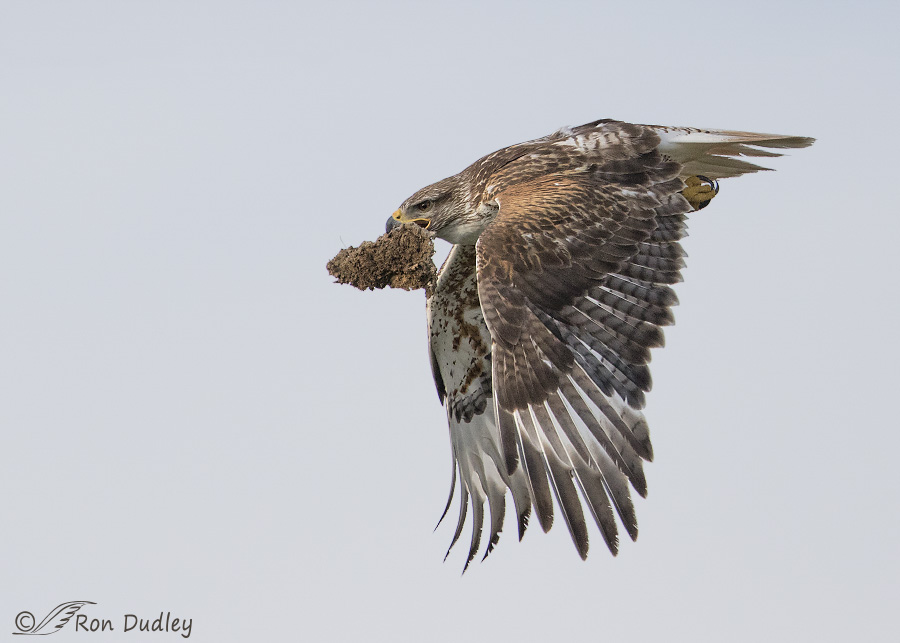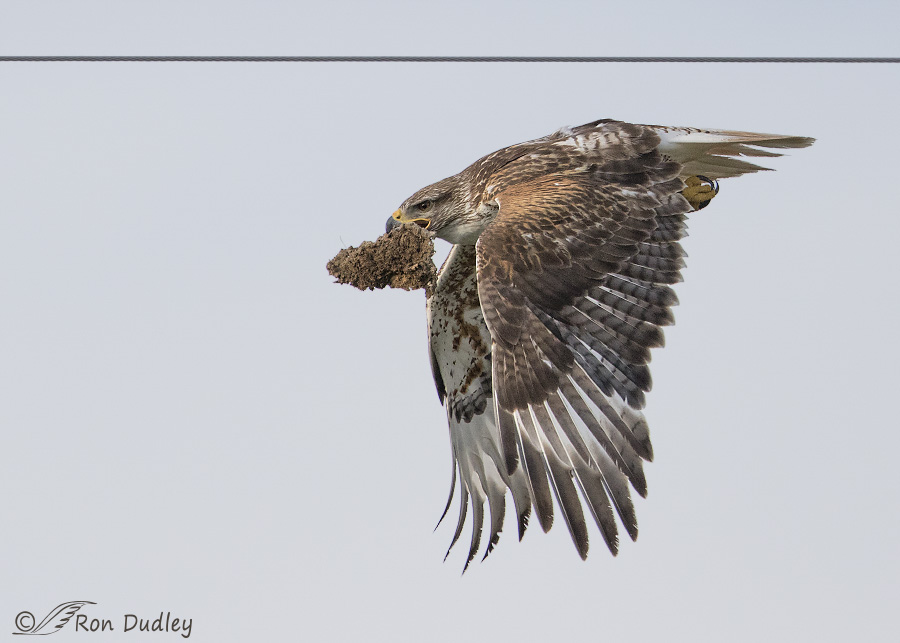The mystery continues as to what this nesting material actually is but I think I have a pretty good guess.
 1/3200, f/6.3, ISO 1000, Canon 7D Mark II, Canon EF 500mm f/4L IS II USM + EF 1.4 III Extender, not baited, set up or called in
1/3200, f/6.3, ISO 1000, Canon 7D Mark II, Canon EF 500mm f/4L IS II USM + EF 1.4 III Extender, not baited, set up or called in
I photographed this light morph Ferruginous Hawk in low light this past summer in Montana’s Centennial Valley. I watched the bird as it left its power pole perch, flew down into a pasture, retrieved something from the ground and then landed back on the pole with it. A few minutes later it launched from the pole again and that’s when I took this shot.
In previous posts of other images of this hawk I’ve speculated about what this material might actually be and I now believe it may be a piece of cow dung. Ferruginous Hawks are known to commonly line their nests with it, there were cows in the area and to me it looks like what we see is the underside of cow dung where it had made contact with the soil.
Some may question the angle of flight of this bird and think the image needs clockwise rotation. But I know this to be reasonably close to the actual flight angle because…

in the first version of the image I had removed a power line that I know was fairly close to level. The bird had actually dived down at an angle from its perch and landed on the ground some distance away. I never did know where the actual nest was (if it had one at all).
Ferruginous means “rust-colored” (ferrous refers to iron) alluding to the reddish colors on the back, wings and legs of light-morph birds so I enjoy seeing those namesake colors in this regal hawk.
Ron


They really are magnificent aren’t they?
They sure are.
And this fun fact from the allaboutbirds.org site: When bison still roamed the west, Ferruginous Hawk nests contained bison bones and hair along with sticks and twigs.
Can you imagine hawks large enough that they use bison bones to build their nests?
Yeah, that’s pretty impressive, isn’t it, Dan. It’s my understanding that they mostly used rib bones but still…
“Bison rib bones” , huh….definitely a liitle eagle…just wrongly categorized…but just for now! Wambli cicola (small or little eagle)
Cow pie, huh? Very interesting.
Yup, a “meadow muffin”…
Pasture pastry.
It used to be buffalo dung.
That’s right, Deborah. They also used to use bison bones (particularly ribs) in their nests.
Looks like the underside of a cow pie to me, thpugh at first it looked a pine cone. It’s a beautiful picture of the bird! Looks like a smaller version of a Golden….
Patty, some think it’s closer to the Golden Eagle than it is to buteos.
You can add me to that group….
Great shot Ron. Love this one!
Thanks, Frank.
Jaw dropping image… Stunning!!!
Thanks very much, Butch.
It never occurred to me that the photo needed leveling/rotation. There’s nothing that says that birds always fly in a straight, perfectly horizontal line… Beautiful bird.
Susan, I still didn’t level it completely accurately. Gravity would have made the power line slope down just a little to my left and when I rotated I made it perfectly level. So actually this hawk’s flight path would have been even a little steeper than I’ve shown it to be.
Interesting behavioral shots Ron. Wonderful information on Ferruginous Hawk nesting material.
Looking back through my records, I have only seen this hawk twice in my life.
Thanks for sharing.
“I have only seen this hawk twice in my life”
That doesn’t surprise me Dick, since they’re almost exclusively a western species. I used to commonly see them in the west desert but for the last several years they’ve been unusually hard to find out there.
I wonder if that’s an issue of prey availability? That, and habitat loss are the primary reasons for raptors to vacate an area. Is there a war against prairie dogs? Poison is also an issue in that the raptors/predators are a secondary poisoning issue. I understand about rabbit cycles and another falconer reported a severe absence of rabbits where once they flourished.
I should have edited that before sending. Redundancy much? Word territory–and I’m a writer/editor, too. Thwaps self!
Laura, I think it may be mostly an issue of habitat. They prefer sparse grasslands and sagebrush country and avoid forests. As far as I know they were never prevalent in the east.
But then you may be referring to my comment instead of Dick’s. If so you may be right about prey availability, especially with the drought conditions around here.
Ron I was speaking of YOUR area responding to your comment. No, like me, they don’t belong on this side of the Mississippi. They’re a prairie/plains bird. Again like me, they like OPEN spaces where they’ve got a little wing/elbow room!
Ron thanks for pointing out the plumage color and demonstrating it so perfectly on the photo. The bird sure looks intent on getting the nest material where it belongs. Thanks again for the description. Diana
You’re very welcome, Diana. Thanks.
What a splendid shot of a magnificent hawk/eagle (yeah, insert all those superlatives here)! One of the (many) things that impresses me about Ferrugs is they routinely catch prairie dogs. Mariah, my female redtail (who is no more MINE than the air I breathe) tired of the prairie dog whack-a-mole game pretty quickly unlike her silly bird dog partner who could have played that game well into eternity 🙂 The typical redtail anvil of death flight doesn’t work well. Instead, Ferrugs generally fly in close to the ground and WHAMMO!
The other amazing thing about them is that WIDE gape. I’ve seen them swallow a cottontail rabbit in very short order (in the realm of two minutes, although I didn’t time it officially. That said, I’m pretty good at estimating time segments in the range of race car lap times).
Marvelous!
And I agree with the cow patty guess, for whatever that’s worth.
You’re right, Laura. The size of their gape is one of the most impressive things about a VERY impressive bird overall.
Beautiful shots, Ron! 🙂 Does appear to be cow dung for sure! Wonder why they line their nests with that? You’d think they’d end up with more insects than the nests normally accumulate. Always something new!
“Wonder why they line their nests with that”
Good question, Judy, but they’re known to use a lot of weird stuff to line their nests. This from BNA Online:
“Cow dung reported in nests throughout range. In mixed-grass ecoregion of Alberta, ≥80% of nest cups are lined with dung and grass sod or stubble, ≤ 20% with bark, forbs, or leafed sprigs (Schmutz et al. 1980). Other items in nests include paper, various bones, barbed wire, plastic, and steel cable found on ground (Palmer 1988).”
Marvelous flight shots Ron! Thanks for sharing!
Charlotte
Thanks, Charlotte.